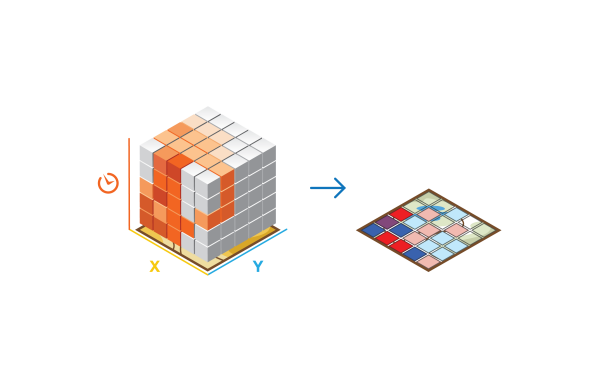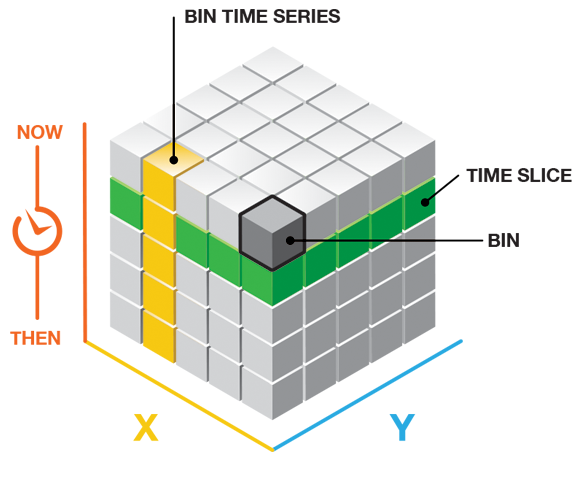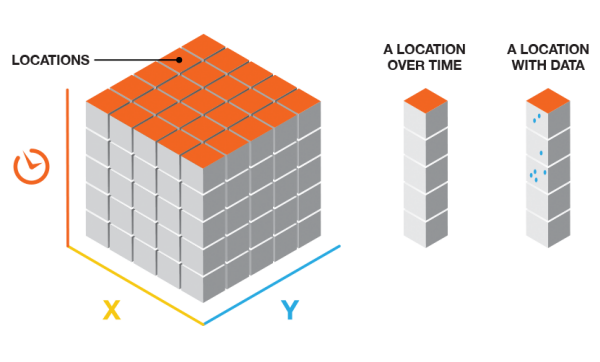Summary
Identifies statistically significant clusters and outliers in the context of both space and time. This tool is a space-time implementation of the Anselin Local Moran's I statistic.
Illustration

Usage
This tool can only accept netCDF files created by the Create Space Time Cube By Aggregating Points tool.
Each bin in the space-time cube has a LOCATION_ID, a time_step_ID, a COUNT value, and any Summary Fields that were aggregated when the cube was created. Bins associated with the same physical location will share the same location ID and together will represent a time series. Bins associated with the same time-step interval will share the same time-step ID and together will comprise a time slice. The count value for each bin reflects the number of points that occurred at the associated location within the associated time-step interval.

This tool analyzes a variable in the netCDF Input Space Time Cube using a space-time implementation of the Anselin Local Moran's I statistic.
The Output Features will be added to the Table Of Contents with rendering that summarizes results of the space-time analysis for all locations analyzed. If you specify a Polygon Analysis Mask, the locations analyzed will be those that fall within the analysis mask; otherwise, the locations analyzed will be those with at least one point for at least one time-step interval.

In addition to the Output Features, an analysis summary is written to the Results window. Right-clicking the Messages entry in the Results window and selecting View will display the analysis summary in a Message dialog box. The analysis summary will also be displayed in the progress dialog box.
The Local Outlier Analysis tool identifies statistically significant clusters and outliers in the context of both space and time. See Learn more about how the Local Outlier Analysis tool works for the default output category definitions and additional information about the algorithms used in this analysis tool.
To identify clusters and outliers in the space-time cube, this tool uses a space-time implementation of the Anselin Local Moran's I statistic, which considers the value for each bin within the context of the values for neighboring bins. A bin is considered a neighbor if its centroid falls within the Neighborhood Distance and its time interval is within the Neighborhood Time Step you specify. When you do not provide a Neighborhood Distance value, one is calculated for you based on the spatial distribution of your point data. When you do not provide a Neighborhood Time Step value, the tool uses a default value of 1 time-step interval.
To determine which bins will be included in each analysis neighborhood, the tool first finds neighboring bins that fall within the specified Neighborhood Distance. Next, for each of those bins, it includes bins at those same locations from N previous time steps, where N is the Neighborhood Time Step value you specify.
The Neighborhood Time Step value is the number of time-step intervals to include in the analysis neighborhood. If the time-step interval for your cube is three months, for example, and you specify 2 for the Neighborhood Time Step, all bin counts within the Neighborhood Distance, and all of their associated bins for the previous two time-step intervals (covering a nine-month time period) will be included in the analysis neighborhood.
Permutations are used to determine how likely it would be to find the actual spatial distribution of the values you are analyzing. For each permutation, the neighborhood values around each bin are randomly rearranged and the Local Moran's I value calculated. The result is a reference distribution of values that is then compared to the actual observed Moran's I to determine the probability that the observed value could be found in the random distribution. The default is 499 permutations; however, the random sample distribution is improved with increasing permutations, which improves the precision of the pseudo p-value.
If the Number of Permutations parameter is set to 0, the result is a traditional p-value instead of a pseudo p-value.
The permutations employed by this tool take advantage of the increased performance available in systems that use multiple CPUs (or multi-core CPUs). The tool will default to use half of the maximum number of CPUs available. The increased processing speed is most noticeable in larger space-time cubes or tool runs with larger numbers of permutations. The number of CPUs used can be increased or decreased using the Parallel Processing Factor environment.
The Polygon Analysis Mask feature layer may include one or more polygons defining the analysis study area. These polygons indicate where point features could possibly occur and should exclude areas where points would be impossible. If you were analyzing residential burglary trends, for example, you might use the Polygon Analysis Mask to exclude a large lake, regional parks, or other areas where there aren't any homes.
The Polygon Analysis Mask is intersected with the extent of the Input Space Time Cube and will not extend the dimensions of the cube.
If the Polygon Analysis Mask you are using to set your study area covers an area beyond the extent of the input features that were used when initially creating the cube, you may want to re-create your cube using the Polygon Analysis Mask as the Output extent environment. This will ensure that all of the area covered by the Polygon Analysis Mask is included in the Local Outlier Analysis tool. Using Polygon Analysis Mask as the Output extent environment setting during cube creation will ensure the extent of the cube matches the extent of the Polygon Analysis Mask.
- This tool creates a new output feature class with the following attributes for each location in the space-time cube. These fields can be used for custom visualization of the output. See Learn more about how the Local Outlier Analysis tool works for more information about the additional analysis results.
- Number of Outliers
- Percentage of Outliers
- Number of Low Clusters
- Percentage of Low Clusters
- Number of Low Outliers
- Percentage of Low Outliers
- Number of High Clusters
- Percentage of High Clusters
- Number of High Outliers
- Percentage of High Outliers
- locations with No Spatial Neighbors
- locations with an Outlier in the Most Recent Time Step
- Cluster Outlier Type
- and additional summary statistics
The Cluster Outlier Type will always indicate statistically significant clusters and outliers for a 95 percent confidence level, and only statistically significant bins will have values in this field. This significance reflects a False Discovery Rate (FDR) Correction.
- Default rendering for the Output Feature Class is based on the CO_TYPE field and shows locations that were statistically significant. It will show locations that have been part of a significant High-High Cluster, High-Low Outlier, Low-High Outlier, Low-Low Cluster, or classified as Multiple Types over time.
To ensure at least 1 temporal neighbor for each location, a Local Moran's Index is not calculated for the first time slice. The bin values in the first time slice are, however, included in the calculation of the global average.
Running Local Outlier Analysis adds analysis results back to the netCDF Input Space Time Cube. Each bin is analyzed within the context of neighboring bins to measure the clustering for both high and low values and to identify any spatial and temporal outliers within those clusters. The result from this analysis is a Local Moran's I Index, pseudo p-value (or p-value if no permutations were used), and a cluster or outlier type (CO_TYPE) for every bin in the space-time cube.
A summary of the variables added to the Input Space Time Cube is given below:
Variable Name Description Dimension OUTLIER_{ANALYSIS_VARIABLE}_INDEX
The calculated Local Moran's I Index.
Three-dimensions: one Local Moran's I Index value for every bin in the space-time cube.
OUTLIER_{ANALYSIS_VARIABLE}_PVALUE
Anselin Local Moran's I statistic pseudo p-value or p-value, which measures the statistical significance of the Local Moran's I value.
Three-dimensions: one p-value or pseudo p-value for every bin in the space-time cube.
OUTLIER_{ANALYSIS_VARIABLE}_TYPE
The result category type distinguishing between a statistically significant cluster of high values (High-High), cluster of low values (Low-Low), outlier in which a high value is surround primarily by low values (High-Low), and outlier in which a low value is surrounded primarily by high values (Low-High).
Three-dimensions: one cluster or outlier type for every bin in the space-time cube. The bin is based on an FDR correction.
OUTLIER_{ANALYSIS_VARIABLE}
_HAS_SPATIAL_NEIGHBORS
Indicates locations that have spatial neighbors and those that are relying only on temporal neighbors.
Two-dimensions: one classification for each location. Analysis of locations that do not have spatial neighbors will result in calculations based purely on temporal neighbors.
Syntax
LocalOutlierAnalysis_stpm (in_cube, analysis_variable, output_features, {neighborhood_distance}, neighborhood_time_step, {number_of_permutations}, {polygon_mask})| Parameter | Explanation | Data Type |
in_cube | The netCDF cube to be analyzed. This file must have an (.nc) extension and must have been created using the Create Space Time Cube By Aggregating Points tool. | File |
analysis_variable | The numeric variable in the netCDF file you want to analyze. | String |
output_features | The output feature class containing locations that were considered statistically significant clusters or outliers. | Feature Class |
neighborhood_distance (Optional) | The spatial extent of the analysis neighborhood. This value determines which features are analyzed together in order to assess local space-time clustering. | Linear Unit |
neighborhood_time_step | The number of time-step intervals to include in the analysis neighborhood. This value determines which features are analyzed together in order to assess local space-time clustering. | Long |
number_of_permutations (Optional) | The number of random permutations for the calculation of pseudo p-values. The default number of permutations is 499. If you choose 0 permutations, the standard p-value is calculated.
| Long |
polygon_mask (Optional) | A polygon feature layer with one or more polygons defining the analysis study area. You would use a polygon analysis mask to exclude a large lake from the analysis, for example. Bins defined in the Input Space Time Cube that fall outside of the mask will not be included in the analysis. | Feature Layer |
Code sample
LocalOutlierAnalysis example 1 (Python window)
The following Python window script demonstrates how to use the LocalOutlierAnalysis tool.
# LocalOutlierAnalysis of homicides in a metropolitan area
arcpy.env.workspace = r"C:\STPM"
arcpy.LocalOutlierAnalysis_stpm("Homicides.nc", "COUNT", "LOA_Homicides.shp", "5 Miles", 2, 499, "#")
LocalOutlierAnalysis example 2 (stand-alone Python script)
The following stand-alone Python window script demonstrates how to use the LocalOutlierAnalysis tool.
# Create Space Time Cube by aggregating homicide incidents in a metropolitan area
# Import system modules
import arcpy
# Set property to overwrite existing output, by default
arcpy.env.overwriteOutput = True
# Local variables...
workspace = r"C:\STPM"
try:
# Set the current workspace (to avoid having to specify the full path to the feature
# classes each time)
arcpy.env.workspace = workspace
# Create Space Time Cube by aggregating homicide incident data with 3 months and 3 miles settings
# Process: Create Space Time Cube By Aggregating Points
cube = arcpy.CreateSpaceTimeCube_stpm("Homicides.shp", "Homicides.nc", "MyDate", "#",
"3 Months", "End time", "#", "3 Miles", "Property MEDIAN SPACETIME; Age STD ZEROS", "HEXAGON_GRID")
# Create a polygon that defines where incidents are possible
# Process: Minimum Bounding Geometry of homicide incident data
arcpy.MinimumBoundingGeometry_management("Homicides.shp", "bounding.shp", "CONVEX_HULL",
"ALL", "#", "NO_MBG_FIELDS")
# Local Outlier Analysis of homicide incident cube using 5 Miles neighborhood
# distance and 2 neighborhood time step with 499 permutations to detect outliers
# Process: Local Outlier Analysis
loa = arcpy.LocalOutlierAnalysis_stpm("Homicides.nc", "COUNT", "LOA_Homicides.shp", "5 Miles",
2, 499, "bounding.shp")
except:
# If any error occurred when running the tool, print the messages
print(arcpy.GetMessages())
Environments
Licensing information
- ArcGIS Desktop Basic: Yes
- ArcGIS Desktop Standard: Yes
- ArcGIS Desktop Advanced: Yes